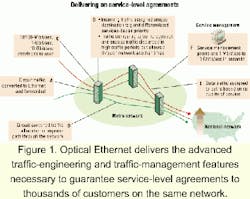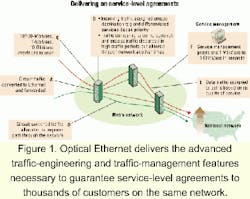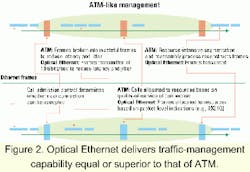SLAs in an optical Ethernet network
Delivering the next-generation high-bandwidth services for the metropolitan-area network.
DAVID YATES, Atrica Inc.
From e-mail to e-commerce, voice to music, the Internet is becoming the communications and information delivery medium of choice. With an ever-increasing demand for Internet and data-based communications, analysts predict an approximate 10-fold growth in overall WAN traffic in the next few years. By 2004, up to 95% of all traffic in the metro area will be carried by Internet Protocol (IP). The need for high bandwidth to carry Internet traffic is here-and growing rapidly in all segments of the market. In this dynamic environment, metro carriers are faced with a critical issue: How will they guarantee quality-of-service (QoS) and the bandwidth that their customers are paying for?
Today's metropolitan-area networks (MANs) are built using SONET technology. SONET is well tested and offers excellent levels of reliability and protection. SONET was designed for synchronous (i.e. circuit-switched) voice traffic and is unmatched in this area. However, growth of the Internet represents a dramatic move from circuit-switched traffic to primarily IP packet-based data traffic. Next-generation metro networks must carry extremely large amounts of IP traffic quickly and enable telephone companies to offer such services cost-effectively. To offer low-cost services, these next-generation networks must be inexpensive to install and operate.
In these areas, SONET does not excel. SONET has always been relatively difficult and expensive to operate, and the next generation of OC-192 (10-Gbit/sec) SONET equipment is proving too costly and inflexible to carry the vast amount of IP traffic required by the Internet economy. OC-192 SONET systems currently cost $200,000 or more. Despite projected cost reductions, SONET systems are still too expensive to provide the 10-Gbit/sec-based network required in this decade.
While SONET was designed for circuit-switched voice traffic, Ethernet is a technology that has grown with the Internet and now dominates nearly all other facets of data networking. Since its development in 1976, Ethernet has taken over sector after sector of the networking world. Surpassing its competition in the workgroup environment, Ethernet rose to new heights of scalability with Gigabit Ethernet and trounced existing competitors such as ATM and FDDI in the enterprise backbone.
Now, a new technology, optical Ethernet, is beginning to revolutionize MANs by delivering very high bandwidths-100 Mbits/sec, 1,000 Mbits/sec, and even higher-across cities and regions at prices similar to today's T1s (1.5 Mbits/sec). Optical Ethernet's combination of high-speed Ethernet, optical networking, and traffic-engineering and traffic-management capabilities, allows carriers to deliver the economics, capacity, and speeds required to build next-generation MANs.
Based fundamentally on Ethernet, optical Ethernet MANs enable carriers to deliver standard, well-known 10/100-Mbit/sec or 1-Gbit/sec Ethernet interfaces, like those used to easily connect office networks today. But instead of a SONET ring, the metro backbone for optical Ethernet networks will be based on the new 10-Gbit/sec Ethernet standard now being completed by the IEEE 802.3ae working group.
Using Ethernet for the metro is, first and foremost, cost-effective. Ethernet is 10 times cheaper than the SONET technology being used today. A simple comparison of the interfaces required to support each of these technologies clearly illustrates the cost issue. An OC-3 (155-Mbit/sec) interface on a SONET multiplexer costs more than $5,000, whereas a 100-Mbit/sec interface on an Ethernet switch costs well below $500.
Ethernet also is a simple, well-tested, widely understood technology. Most traffic in the enterprise is Ethernet, and if the metro network is Ethernet-based, no complex protocol conversions are required, making troubleshooting far easier.
In addition, Ethernet is the best technology for carrying IP traffic. Ethernet and IP have grown up together. Due to its reliability and simplicity, Ethernet is an excellent technology for delivering the dynamic bandwidth that IP applications typically need and for concentrating many end users, each with rapidly changing traffic profiles, onto a network.
Combining Ethernet with optical networking creates a flexible and cost-effective solution for the metro market that is highly manageable and interoperable with existing networks. First of all, optical technologies allow Ethernet networks to extend over much larger distances than office, or even campus, Ethernet networks. Running over singlemode fiber at 1,310-nm or 15xx-nm wavelengths, optical Ethernet allows links in the network to be 5-10 km in the case of 1,310-nm technology-and up to 70 km and beyond for 15xx nm.
Secondly, optical Ethernet enhances the reliability and deployability of Ethernet-based networks and particularly enables carriers and even end users to add and change connections across a metro network in seconds, rather than the weeks and months required by today's networks. Where traditional SONET-based networks are inflexible, difficult to change, and hard to configure, optical Ethernet-based networks offer flexible topologies and modern protocols that together reduce the carriers' costs of management and support.
Initial estimates project that carriers building next-generation, high-capacity MAN infrastructures using optical Ethernet equipment should be able to reduce their equipment acquisition costs by 85% or more, as compared to similar-speed SONET-based equipment. In addition, deployment costs will be substantially reduced.
To configure a connection over a large SONET network requires operators to manually map individual connections across multiple, different SONET rings. That takes a great deal of time. In addition, SONET is such a unique and complex technology that the type of people who can perform these functions are in very short supply. In comparison, Ethernet is widely deployed and easily understood. Connections can be established automatically, and it is quite easy for operators to find technicians qualified to handle Ethernet equipment, since it is used in virtually every business.
Thirdly, optical Ethernet will help carriers better manage costs. Because it is a simpler technology, it is easier to troubleshoot and manage. Also, as a second-generation metro implementation (the first being SONET), optical Ethernet developers can design their management and hardware/software platforms together, from the beginning, to meet the demands of service-provider managers. That contrasts with the first generation of products that often have to be tuned and redesigned to meet these same high-level management standards.
Lastly, when it comes to networking, users understand Ethernet much better than they understand SONET. That makes optical Ethernet a more user-friendly technology-an important point as an increasing number of users find themselves working more closely with their service providers to provision, manage, and monitor their network services.
A service-level agreement (SLA) is a contract between the end user and carrier, covering metrics such as availability, bandwidth, latency and jitter, speed of protection, and time to provision/re-provision. With optical Ethernet, these metrics are built into the technology, giving carriers the advanced traffic-engineering and traffic-management capabilities they need to guarantee SLAs to thousands of customers on the same network.
In any SLA, the provider must keep each user's traffic segregated to deliver to each user the bandwidth and service quality that is expected per the SLA. If users are paying for 45 Mbits/sec, they expect to get that, not 10 Mbits/sec when the network is busy and 45 Mbits/sec at other times. Optical Ethernet gives carriers the ability to segregate the traffic of different users and deliver the particular service level each user has purchased.
To achieve traffic segregation, optical Ethernet follows the lines of current Ethernet standards. Today's SONET technologies separate users' traffic using time-division multiplexing (TDM) technology, allocating each user a specific time slot. Ethernet already has a standard for separating user traffic using a method very similar to frame relay ATM's use of virtual circuits: the IEEE 802.1pQ virtual local-area network (VLAN) standard. This standard enables optical Ethernet networks to mark each user's traffic with a VLAN tag as it enters the network, then use the tag to keep each user's traffic separate as it crosses the network.To date, there are two challenges with the VLAN standard: (1) Users may already be using this tagging methodology for their own purposes, and (2) the VLAN standard was designed for the needs of individual enterprises and only allows a total of 4,096 VLANs in a network-a number that is too small to be useful to carriers. To handle these difficulties, the IEEE is recommending that the IEEE VLAN standard be extended to handle 16 million different user connections via a technique known as Q-tag stacking-essentially, adding a second VLAN identification field.
SLAs must ensure each user receives the services purchased in terms of bandwidth and QoS. Optical Ethernet has the traffic-engineering capabilities to deliver guaranteed levels of latency, jitter, and bandwidth by using the techniques developed in the Internet Engineering Task Force differentiated services (DiffServ) project (see Figure 1). DiffServ specifies using information in each packet to divide traffic into various classes of service and gives traffic the designated class of service through the network. Optical Ethernet uses the classes of service included in the IEEE 802.1pQ standard. As user packets enter the network, the edge equipment marks the traffic with the appropriate class of service corresponding to what the user has purchased. The optical Ethernet network then handles each packet to deliver the delay and jitter appropriate for this marking.
To ensure user bandwidth contracts are met, the same type of techniques can be applied. The rate of incoming traffic is compared to the user's contract. Traffic above contract is carried, but only as long as it does not congest resources required to carry guaranteed traffic.
Time to provision/re-provision measures whether users' requests to change their service parameters (e.g., bandwidth) were honored and, if so, how long the interval is between request and execution of the request. In current SONET-based networks, the time to provision is typically two months or more. SONET networks are built as a series of discrete rings, and circuits have to be manually configured across the many rings sometimes required to traverse a MAN. Optical Ethernet networks, on the other hand, can be provisioned in seconds. Modern management systems and automated traffic-engineering tools enable optical Ethernet networks to be provisioned automatically and in fact can be provisioned by the subscriber if the service provider is prepared to allow it.
Using the techniques outlined, optical Ethernet networks can easily handle the needs of data applications, delivering large bandwidth cheaply and reliably. Optical Ethernet networks can also meet the needs of traditional circuit-switched traffic, such as voice. Circuit traffic requires only modest bandwidth, but quite demanding levels of latency and jitter. Typically, delay across a circuit-switched network is required to be 50 msec or less, with very low jitter.
Historically, to deliver the required levels of latency and jitter in a packet-switching network, it has been necessary to break up packets into smaller units known as cells. Optical Ethernet easily achieves "toll-quality" levels of delay and jitter, not by segmenting packets but by accelerating them. When networks run at 10 Gbits/sec, the delay for even a maximum-sized packet to transit a link (the "serialization" delay) is almost 10 times less than the delay for a 53-byte ATM cell to traverse a DS-3 (44.736-Mbit/sec) link.
Besides offering far more bandwidth far more cost-effectively, another major advantage of optical Ethernet over SONET/ATM is its flexibility. This flexibility makes it much easier and less expensive for service providers to offer a range of services to their end users. For instance, SONET's use of fixed and inconvenient bandwidths (1.5 Mbits/sec, 45 Mbits/sec, 150 Mbits/sec, etc.), coupled with different physical interfaces, makes it hard to select the correct SLA for an application and even harder to change that SLA later. Unlike SONET, optical Ethernet offers users a single uniform interface that can support any SLA between 1 Mbit/sec and 1 Gbit/sec. Even better, because the interface supports such a broad array of SLAs, the SLA can be quickly and easily re-provisioned.
Optical Ethernet is more flexible than SONET in other ways, as well. First, while SONET only offers point-to-point circuits, optical Ethernet can provide both point-to-point and LAN-like multipoint connections.
SONET also has only one category of latency and jitter (i.e., low latency and low jitter). That adds to the expense of SONET solutions and means that service providers are unable to tap into the market for customers who require a different type of SLA. For instance, many data customers would prefer a service that offers the ability to burst to high levels, even if that means they need to tolerate fairly high levels of jitter.
Optical Ethernet offers a mix of different types of SLAs. The Ethernet circuit emulation service category delivers SONET-like latency and jitter. But on the same optical Ethernet network, carriers can offer services appropriate for bursty data traffic that, for instance, guarantee a minimum bandwidth but allow a large amount of burst capability.Perhaps surprisingly, given ATM's reputation, optical Ethernet also delivers equal or superior SLA management capabilities to ATM. In fact, many of the basic mechanisms used to achieve SLA management in ATM-call admission control, policing, dedicating resources to one quality of service or another-are also used in optical Ethernet (see Figure 2). The difference is that while ATM involves complex segmentation and reassembly, switched virtual circuits, private-network node interface (PNNI), etc., optical Ethernet networks remain simple by using the speed and elegance of the Ethernet protocol itself.
Optical Ethernet can deliver very large amounts of bandwidth-as much as 10 times less expensively than current technologies. Optical Ethernet delivers these services and economics in a package that offers the features and functions carriers need. Principal among these is the ability to deliver guaranteed SLAs. Using tagging protocols, DiffServ, and other standard technologies, optical Ethernet offers the guarantees that enterprise Ethernet does not, such as on bandwidth, packet loss, latency, and jitter. Optical Ethernet also goes many steps further than SONET in the area of SLA management, offering not only a single category of SLAs, but also enabling service providers to tailor the SLA packages they offer to the needs of individual segments of their customers.
David Yates is vice president of marketing for Atrica Inc. (Santa Clara, CA). He can be reached via the company's Website, www.atrica.com.


